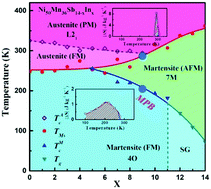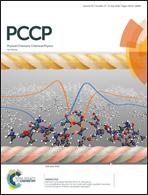Zero-thermal-hysteresis magnetocaloric effect induced by magnetic transition at a morphotropic phase boundary in Heusler Ni50Mn36Sb14−xInx alloys
Abstract
With the development of magnetic refrigerant technology, magnetic substances with a large magnetocaloric effect (MCE) and nearly zero thermal hysteresis are desired. Although Ni–Mn based Heusler alloys have been found to produce large MCEs and have attracted increasing attention recently, the occurrence of thermal hysteresis accompanying MCE due to the nature of first-order phase transition limits its applications with magnetic refrigeration. Up to now, an effective theory or method to eliminate this thermal hysteresis is still lacking. Here, we propose to utilize the feature of magnetic transition at the morphotropic phase boundary (MPB) to eliminate thermal hysteresis and thus design a MPB-involved phase diagram in Heusler alloys of Ni50Mn36Sb14−xInx (x = 0–14). As theoretically expected, the magnetic transition at MPB really yields a MCE with a negligible thermal hysteresis (∼0 K) and the refrigerant capacity arrives at a maximum value of 108.2 J kg−1 at the composition of x = 9. Our findings provide an effective way to design large MCE materials with zero thermal hysteresis.



 Please wait while we load your content...
Please wait while we load your content...
